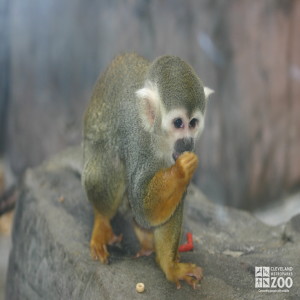Common Squirrel Monkey
[Saimiri sciureus]

The common squirrel monkey has a head and body length that is 10.4 to 14.4 inches long. The tail length is 14 to 17 inches and the weight is 2.5 to 3.7 pounds. The tail is not prehensile.These diurnal monkeys are arboreal and only occasionally descend to the ground. Movement is quadrupedal with relatively little leaping. Ranges are often ill-defined and troops may number into the 40 to 50 range. During the mating season males establish a dominance hierarchy through fierce fighting with the higher-ranking individuals then interacting with the females. The females establish a dominance hierarchy during pregnancy. After the birth of the young, females exclude the males. The newborn cling to their mothers back for the first few weeks of life. Independence is achieved at 1 year.
Location: Animals Formerly at Zoo
Share:
Range
The range of the common squirrel monkey is east of the Andes from Colombia and northern Peru to north- eastern Brazil
Habitat
Common squirrel monkey habitats are primary and secondary forests, cultivated areas, usually along streams.
Conservation Status
Least ConcernPrimary Threats
Agriculture. Human-Wildlife CoexistenceGestation
152-172 days
Litter
1
Behavior
Common squirrel monkeys are arboreal and only occasionally descend to the ground. Movement is quadrupedal with relatively little leaping. Wild troops are most active from early to mid-morning and mid- to late afternoon, usually resting an hour or two at midday. Ranges are often ill-defined and troops may number into the 40-50 range. Groups are known to split during the day into subgroups of pregnant females, females with young and adult males.
Reproduction
During the mating season, common squirrel monkey males establish a dominance hierarchy through fierce fighting with the higher-ranking individuals then interacting with the females. The females establish a dominance hierarchy during pregnancy. After the birth of the young, females exclude the males. There is a 2-4 month breeding period during the dry season with births occurring from late June to early August. The estrous cycle is believed to be 7-13 days with estrus lasting 12-13 hours. The newborn cling to their mother's back for the first few weeks of life. Independence is achieved at 1 year. Reproductive maturity is reached by females at 3 and by males at 5.
Wild Diet
Fruits, berries, nuts, flowers, buds, seeds, leaves gum, insects, arachnids and small invertebrates
Zoo Diet
New World monkey chow, apples, banana, yams, lettuce, grapes, oranges, endive and mealworms
